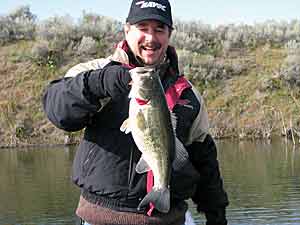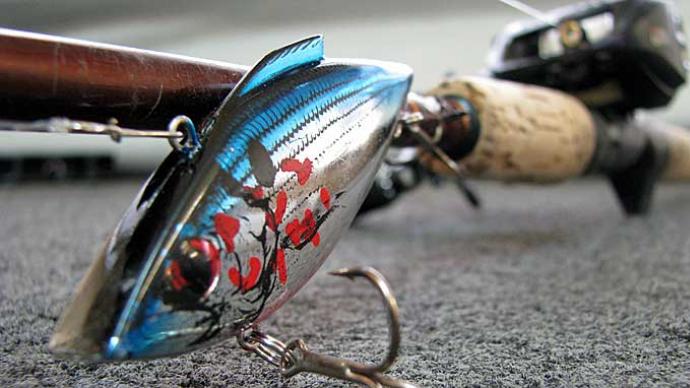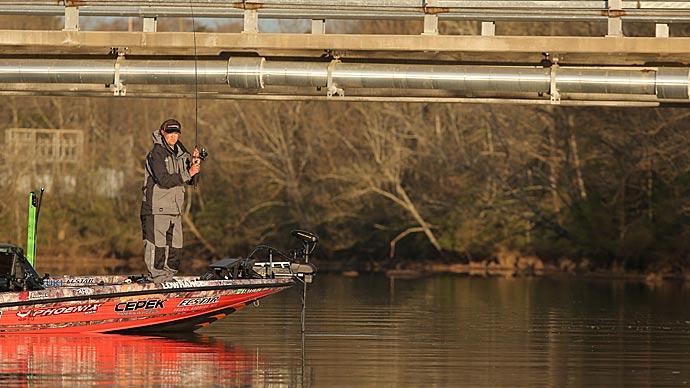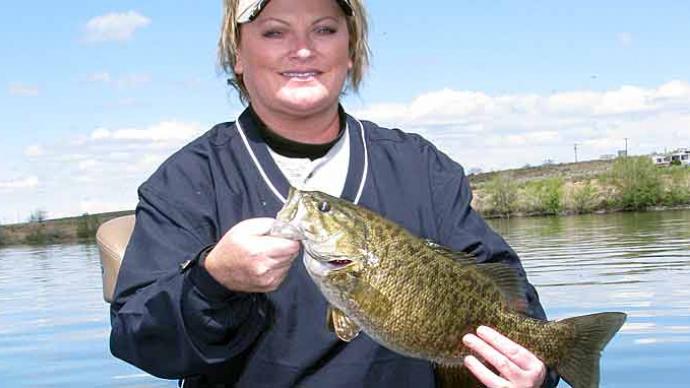
When I first became introduced to the lipless crankbait, I was primarily in the "farm pond" phase of my fishing career. When I could get off after school or during the summer, my trusty (?) 1947 four-cylinder Willis would hit the county roads of Lamar and Red River county, finding as many folks as possible who would let a kid cast in their farm pond. Among the actual producers in my tackle box were some swimming minnow-type baits. These included the Bayou Boogie made just up the Red River by Whopper Stopper, the Sonic introduced by Heddon, and the Pico Perch made down on the coast. All of them had the same features that make the modern-day versions of this plug the choice of both beginners and the pro fisherman.
For starters, they would cast with little wind resistance and, after a bit of practice, could significantly improve your accuracy for placing them in distant pockets not easily reached by lighter lures. Another feature was that you had a hard time not catching fish on the baits. This was even if you threw and wound in the plugs since they had an inherent wiggle that drove fish nuts. The other real advantage, soon learned by anglers, was that these baits could be used as what is now referred to as a countdown plug. This increased my ability to fish the depths where the bass equivalent of Moby Dick surely lived. This ability to fish the deeper water was most important when fishing clear-water ponds during hot, bright summer days.
My bass fishing, as well as everyone else, entered the "worm age" created when Mr. Nick Creme introduced an artificial worm, and someone found out you could Texas rig the bait rather than wad it up on the hook as per his original idea. While I enjoyed worm fishing, I couldn't get away from my original "roots" of using crankbaits, with the swimming minnows being a critical part of the arsenal.
The Cordell Hot Spot offered a slightly different design and several different colors from which to choose than some of the earlier plugs. The design also gave a slightly different vibration in the water, and as with all these plugs, the attraction is not only the image seen by the bass but also the vibration sent through the water as they wiggle.
If being copied is flattery, then surely the Spot was a reference point for several similar plugs. Finally, however, one really charged into the marketplace. When I first saw a Rat-L-Trap, I took a "so what" approach. After all, the bait had a fin on its back, and other than that, the only thing different was it was supposed to have a rattle. My first shot at trying one was in a Jon boat, and the sonic waves from the sound chamber were heard through the hull like you were sitting in the drum section of a Latin band.
So now we had vibration, good "castability," excellent color patterns, and the vibration inherent with the wiggle as it swam, plus the effect of a sound chamber. The latter's value became very obvious in muddy water or low-light conditions where the ability of a bass to find prey includes taking full advantage of its ability to "feel" food as it moves in the environment.
Some things about these baits drive the soft plastic purists a little nuts. One is that crankbaits are likely to be thrown by a fighting bass. This results from a couple of features, including that some of these plugs have either small hooks or wire-type hooks without very much holding power or much of a barb for penetration to withstand the head-shaking fight of a bass. The first thing I usually hear as a complaint from a new fisherman is that you lose a lot of fish on these baits. Any time you put on a larger hook, you will have a greater likelihood of hooking the cover. On the other hand, you are also increasing the hook-holding capability of the plug by simply giving the bait some hooks with a larger bite on the hookset. A thrashing fish with such plugs is often lost because the hook wasn't large enough to get under the lip and penetrate the softer tissues, where you get a more durable hold. Along these same lines, you must use sharp hooks. You need to check the hooks periodically to ensure that they don't have a bent or broken barb and use a good quality replacement hook when re-rigging.
You may notice that some of these plugs have a larger hook on the front than on the back. I haven't asked about the intent of the companies, but as a fact, this imbalance helps in several areas with these baits. To begin with, these plugs don't have a lip to help shield the hooks on the retrieve. However, the front weight of the larger hook makes the plug run nose down; therefore, the body of the plug somewhat shields the hooks on the retrieve. The larger hooks will also cause the same bait to drop at a more rapid speed, which is a point you may want to factor in when modifying the baits if you plan to use them very much in a countdown approach.
These are the ultimate "finder" baits because you can cover a lot of water in a short period. They also can be used to locate the depth at which fish are holding by simply working them in at one speed with one cast and at a different speed that will work them either shallower or deeper on the next cast. Be very sensitive to the retrieve rate when you get a hit and the retrieve you are using. Did the fish hit on a more constant retrieve, a stop-and-start retrieve, or when you used bursts of speed in various sequences on retrieve? While it is sometimes vital to "agitate" a bass into hitting, you must remember these baits move out of the strike zone relatively soon with most retrieves. But you can still get the bass to pay attention because you have the luxury of placing several casts into a likely-looking area by the time you retrieve and cast a slower-working bait.
The lures come in various sizes, but while you may get more hits on the small versions of the plugs, the hooks alone make it difficult to land a good bass. A good compromise is to start with a 1/2-ounce-sized plug, but don't hesitate to use the next size with your favorite version. Just remember that these will fall more rapidly and require a faster retrieve to keep them at the same level on a retrieve as the lighter version. While you may want the bait to fall faster in some instances, other situations may require your bait to run shallower. This is particularly true for those lucky enough to have hydrilla or other underwater vegetation in their lake. Many tournament anglers have made money from learning to "tick" the tops of the grass beds with lipless crankbaits.
I noted that the different plugs from various companies have similar vibrations on a retrieve and different sound or noise features due to the presence or, in some cases, the absence of rattles. I have at least convinced myself that the noise feature is extremely valuable in poor light or muddy water. However, I also carry a second bait of the same color pattern, which makes less noise or even is without a noise chamber that I will use in clear water or good light conditions. My totally "un-guaran-teed" logic is that too much of a good thing can repel a fish just as under certain other conditions attract them. I have tested this concept in schools, and between my ears, there is a fundamental distinction as to when to use the noisiest emitting bait I can find. This is much like the topwater purist who sometimes wants the noisiest bait and, at other times, works a subtle and quieter approach on the retrieve.
Most folks don't think of metal versions when talking about lipless crankbaits. These aren't new plugs and fit an occasional application very well. If the other plastic baits cast without much resistance from the wind, these plugs throw as though they have a second-stage rocket to propel them. If, for example, schools are breaking in open water, a long cast is often essential if you hit them while they are up. The two plugs that fit this type are the Cotton Cordell Gay Blade and the Heddon Sonar Blade. These baits have excellent vibration on the slightest movement and are great baits when you want a rapid fall. The plugs also have two to three holes for line or snap tying. Like the oversized front hook on the plastic versions, the different holes cause different angles of the front of the lure on retrieve ranging from nearly parallel to a very sharp angle with the nose down. These baits have one downside: if anything, I found them to be easier for the fish to throw than plastic plugs. Unfortunately, when they are thrown, they also become a projectile, which can cause a significant hurt to your body if you happen to be on the receiving end of the released plug.
There have been several attempts to make lipless crankbaits out of soft plastic. Most have had a consistent action between baits or didn't catch the fisherman's eye. The two most successful are plugs which get their action by having a unique design within the body which catches the water and causes a swimming action upon retrieve or when falling in the water. Those patterned with a tail-induced action include the Sassy Shad by Mr. Twister. Of more recent vintage are those which take advantage of some mid-body feature, which creates a swimming action. A French company made the first of these types of lures that I saw. The ad in the fishing magazine touted it as lethal on all types of fish (and the ad was also trying to catch all types of pocketbooks). The Creme company expanded its small Lit'l Fishie series to include larger shad and perch versions. Both of these baits are relatively light, catch the wind as you cast them, and are, therefore, most often used on a jig hea4 or with some type of lead rig that permits easier casting. Their action can be exploited in using them as a weedless rig that free-floated over water lilies or hydrilla. Because they are light, you must use lighter lines to get reasonable-length casts.
If the hard plastic lipless baits are the hot sellers, what colors do you want to pick? First, be sure that everyone has a chrome color if they only have one such bait. The other colors of choice are chartreuse, and in the spring, an all-time favorite is red or red/orange.
As with all crankbaits, these are finder baits and can cover a lot of water. But just as with all crankbaits, your best presentation is often one you must establish to meet the pattern of a given day. The good news is that anyone can catch fish on the plugs without a deep thought process. This also means that these are excellent to start with in teaching a young fisherman how to catch bass and keep him busy winding in a plug that won't pull very hard but will give enough vibration on the rod to convey that something is always happening.
BassResource may receive a portion of revenues if you make a purchase using a link above.




